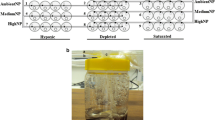Abstract
Leaf material was incubated in flasks containing streamwater in which the pH and the concentration of isolated fulvic acid were varied independently of one another. Decomposition of the leaf material was slower at pH 4 than at pH 5 or 7, but the concentration of fulvic acid had no effect when the pH was held constant. At pH 5, 20 mg Cl−1 humic acid also had no effect on decomposition. High concentrations of dissolved fulvic acids may contribute to the slow decomposition of plant litter characteristic of many wetlands through their contribution to hydrogen ion activity, but we could find no evidence for other properties of fulvic acid which inhibit leaf litter decomposition.
Similar content being viewed by others
References
Acharya, C. N., 1935. Studies on the anaerobic decomposition of plant materials. III. Comparisons of the course of decomposition of rice straw under anaerobic, aerobic, and partially aerobic conditions. Biochem. J. 29: 1116–1120.
Basaraba, J. & R. L. Starkey, 1966. Effects of plant tannins on decomposition of organic substances. Soil Sci. 101: 17–23.
Benner, R., M. A. Moran & R. E. Hodson, 1985. Effect of pH and plant source on lignocellulose biodegradation rates in two wetland ecosystems, the Okefenokee Swamp and a Georgia salt marsh. Limnol. Oceanogr. 30: 489–499.
Blood, E. R., 1982. Surface water hydrology and biogeochemistry of the Okefenokee Swamp watershed. Ph.D. Dissertation, University of Georgia, Athens, GA, USA, 194 pp.
Brakke, D. F., A. Henriksen & S. A. Norton, 1987. The relative importance of acidity sources for humic lakes in Norway. Nature 329: 432–434.
Brinson, M. M., A. E. Lugo & S. Brown, 1981. Primary productivity, decomposition and consumer activity in freshwater wetlands. Ann. Rev. Ecol. Syst. 12: 123–161.
Christman, R. F., W. T. Liao, D. S. Millington & J. D. Johnson, 1981. Oxidative degradation of aquatic humic material. In L. H. Keith (ed.), Advances in the Identification and Analysis of Organic Pollutants in Water, vol 2. Ann Arbor Science, Ann Arbor, MI, USA: 979–999.
Francis, A. J., H. L. Quinby & G. R. Hendrey, 1984. Effect of lake pH on microbial decomposition of allochthonous litter. In G. R. Hendrey (ed.) Early biotic responses to advancing lake acidification. Ann Arbor Science, Ann Arbor, MI, USA: 1–21.
Godshalk, G. L. & R. G. Wetzel, 1978. Decomposition in the littoral zone of lakes. In R. E. Good, et al. (eds) Freshwater Wetlands: Ecological Processes and Management Potential. Academic Press, NY: 39–51.
Gorham, E., S. J. Eisenreich, J. Ford &M. V. Santelmann, 1985. The chemistry of bog waters. In W. Stumm (ed.) Chemical Processes in Lakes. John Wiley & Sons, New York: 339–362.
Gorham, E., J. K. Underwood, F. B. Martin & J. G. Ogden, 1986. Natural and anthropogenic causes of lake acidification in Nova Scotia. Nature 324: 451–453.
Havas, M., T. C. Hutchison & G. E. Likens, 1984. Red herrings in acid rain research. Envir. Sci. Technol. 18: 176A-184A.
Janzen, D. H., 1974. Tropical blackwater rivers, animals, and mast fruiting by the Dipterocarpaceae. Biotropica 6: 69–103.
Kuenzler, E. J., P. J. Mulholland, L. A. Ruley & R. P. Sniffen, 1977. Water quality in North Carolina Coastal Plain streams and effects of channelization. Water Resources Research Inst., Rpt. 127, University of N.C., Raleigh, NC, USA, 73 pp.
Ladd, J. N. & J. H. A. Butler, 1975. Humus-enzyme derivatives in soil. In E. A. Paul & A. D. McLaren, (eds) Soil Biochemistry, vol. 4. Marcel Dekker, New York: 143–186.
Mato, M. C. & J. Mendez, 1970. Inhibition of indoleacetic acid-oxidase by sodium humate. Geoderma 3: 255–258.
Qualls, R. G. & J. D. Johnson, 1983. Kinetics of the short-term consumption of chlorine by fulvic acid. Envir. Sci. Technol. 17: 692–698.
Strickland, J. D. H. & T. R. Parsons, 1968. A practical handbook of seawater analysis. Bull. Fish Res. Bd Can., 167: 310 pp.
SAS Institute Inc., 1985. SAS user's guide: statistics. Version 5 ed., Cary, N.C., USA, 958 pp.
Thurman, E. M. & R. L. Malcolm, 1981. Preparative isolation of aquatic humic substances. Envir. Sci. Technol. 15: 463–466.
Thurman, E. M., 1985. Organic geochemistry of natural waters. Martinus Nijhoff/Junk, Boston, MA, USA, 493 pp.
Traaen, T. S., 1980. Effects of acidity on decomposition of organic matter in aquatic environments. In D. Drabløs & A. Tollan (eds) Ecological Impact of Acid Precipitation. Oslo-⫗As, Oslo: 340–341.
Wetzel, R. G., 1983. Limnology. 2nd ed. Saunders College Pub., New York, 743 pp.
Author information
Authors and Affiliations
Rights and permissions
About this article
Cite this article
Qualls, R.G., Haines, B.L. The influence of humic substances on the aerobic decomposition of submerged leaf litter. Hydrobiologia 206, 133–138 (1990). https://doi.org/10.1007/BF00018639
Received:
Revised:
Accepted:
Issue Date:
DOI: https://doi.org/10.1007/BF00018639




